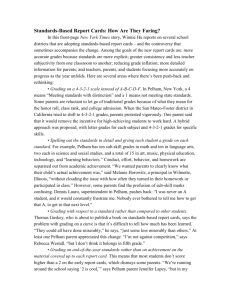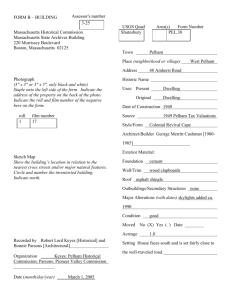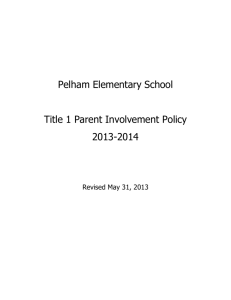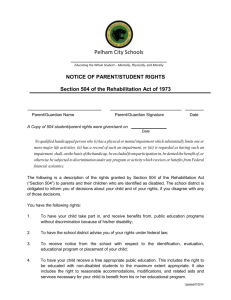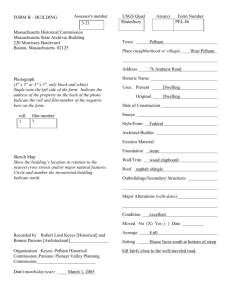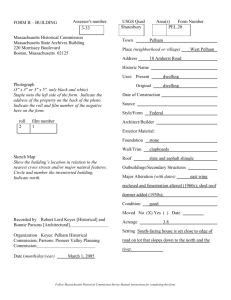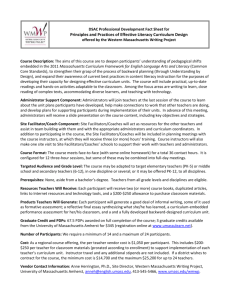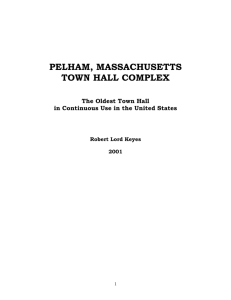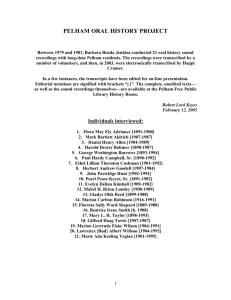8 Amherst Road - Pelham Library
advertisement
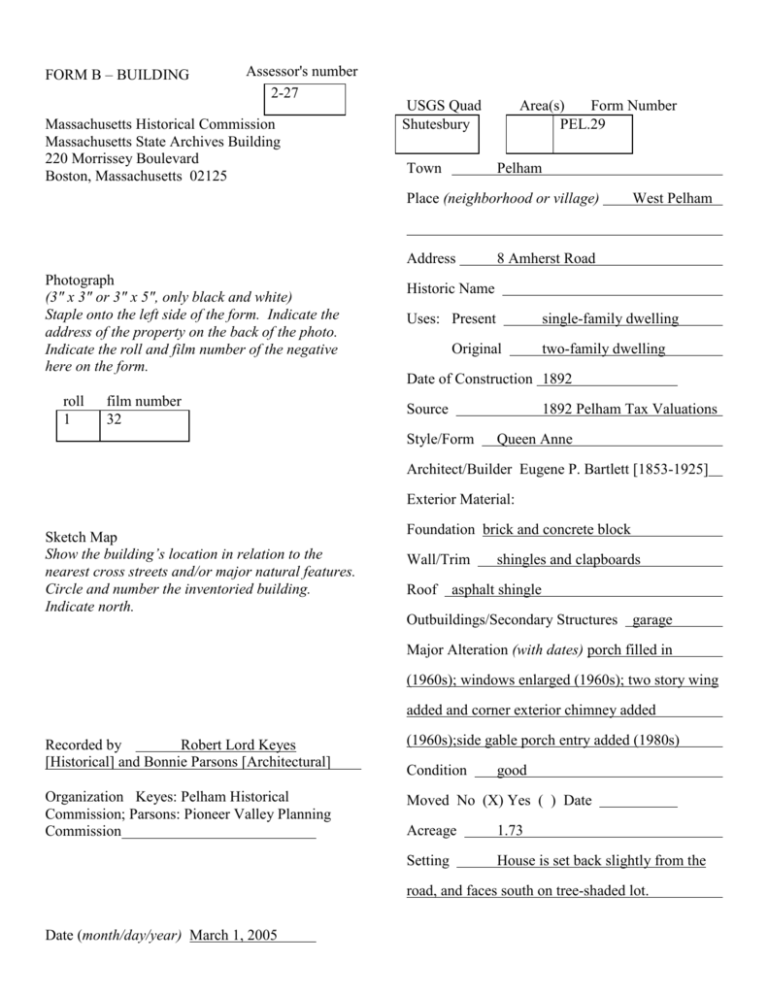
FORM B – BUILDING Assessor's number 2-27 Massachusetts Historical Commission Massachusetts State Archives Building 220 Morrissey Boulevard Boston, Massachusetts 02125 USGS Quad Shutesbury Town Area(s) Form Number PEL.29 Pelham Place (neighborhood or village) Address Photograph (3" x 3" or 3" x 5", only black and white) Staple onto the left side of the form. Indicate the address of the property on the back of the photo. Indicate the roll and film number of the negative here on the form. roll 1 film number 32 West Pelham 8 Amherst Road Historic Name Uses: Present single-family dwelling Original two-family dwelling Date of Construction 1892 Source Style/Form 1892 Pelham Tax Valuations Queen Anne Architect/Builder Eugene P. Bartlett [1853-1925] Exterior Material: Sketch Map Show the building’s location in relation to the nearest cross streets and/or major natural features. Circle and number the inventoried building. Indicate north. Foundation brick and concrete block Wall/Trim shingles and clapboards Roof asphalt shingle Outbuildings/Secondary Structures garage Major Alteration (with dates) porch filled in (1960s); windows enlarged (1960s); two story wing added and corner exterior chimney added Recorded by Robert Lord Keyes [Historical] and Bonnie Parsons [Architectural] (1960s);side gable porch entry added (1980s) Organization Keyes: Pelham Historical Commission; Parsons: Pioneer Valley Planning Commission Moved No (X) Yes ( ) Date Condition good Acreage 1.73 Setting House is set back slightly from the road, and faces south on tree-shaded lot. Date (month/day/year) March 1, 2005 BUILDING FORM ARCHITECTURAL DESCRIPTION see continuation sheet Describe architectural features. Evaluate the characteristics of this building in terms of other buildings within the community. This is a late 19th century house that has few stylistic features but mixes several decorative features of the styles of the period from Queen Anne to Colonial Revival. This eclectic approach demonstrates that many builders and designers at the end of the Queen Anne period looked at styles as one great collection of ornaments from which to choose and apply to a building exterior. The house is a two-and-a-half story gable-and-wing form house whose one-story corner porch has been enclosed. The house has shingles on the street elevation and clapboards on its side elevations. The roof is asphalt shingle and the house sits on brick foundations which was typical of the time of construction. In the gable end of the house is a Queen Anne style, multipaned window, while the porch uses Colonial Revival style paneled posts and pilasters at its entry portico. While original sash is probably that 2/2 found in the gabled portion of the house, in the 1960s it would appear that the house was “modernized” with so-called picture windows being inserted on the first floor, street elevation. There is a twobay garage west of the house that has novelty siding, suggesting a date from the 1920s. HISTORICAL NARRATIVE see continuation sheet Discuss the history of the building. Explain its associations with local (or state) history. Include uses of the building, and the role(s) the owners/occupants played within the community. 8 Amherst Road was originally part of Lot 58-3 [58th lot in the third division] drawn by James Thornton, Sr. [ca. 1684-1754] in 1739. Thornton was one of the founders of Pelham. He was one of two agents for the proprietary company which purchased the land from speculator Col. John Stoddard [1682-1748] that eventually became the town of Pelham. Thornton’s son, Dr. Matthew Thornton [1714-1803] lived in Pelham for a time and was signer of the Declaration of Independence in 1776 from New Hampshire. There is no evidence of a house on this property prior to 1892 when Montague City Fish Rod Factory owner Eugene P. Bartlett [1853-1925] built the present house. It is assumed that Bartlett purchased the lot from the heirs of John Parmenter [ca. 1782-1855], who owned the surrounding lands next door at 18 Amherst Road. [This is suggested by Hampshire County Deed 682-119 (1911) for 4 Amherst Road, among other sources.] Bartlett’s Fish Rod Factory was in full operation just up the street at 22 Amherst Road in 1892. In order to attract and maintain a labor force for his factory, Bartlett bought several West Pelham houses over the years and built a couple others to house his workers (some of whom were close relatives). Bartlett was also instrumental in obtaining a branch line of the Amherst trolley to run past his factory. 8 Amherst Road was the first such house which Bartlett built. It is listed in 1892 Pelham Tax Valuations as being a “new house” and (by 1908) the “two tenement house.” A new barn appears in 1900. It is not yet possible to reconstruct the names of the families who lived in these two apartments between 1892 and 1926 when the property was sold after Bartlett’s death. Lucien T. Lambert [1899-1995] purchased the one-half acre property from the Bartlett heirs. Lambert worked for many years as a purchasing agent for the U.S. Post Office in Amherst. Lambert had moved from a house on Pelham Hollow Road, the site of which is now in Gate 11 of the Quabbin Reservoir. (Lambert also lived for a time on Enfield Road, Pelham, in between living on Pelham Hollow Road and at 8 Amherst Road.) Lambert’s former Gate 11 residence, possibly, gave rise to the unsupported story that 8 Amherst Road “was a house that had been moved out of the Quabbin.” Lambert was a Pelham Selectman 1947-1951. Pelham Tax Valuations list a garage on the property by 1930, 2 henhouses by 1940, and a gas pump and tank by 1946. Lambert had an Follow Massachusetts Historical Commission Survey Manual instructions for completing this form. automobile repair shop business as a sideline for a time at 8 Amherst Road. By 1940, Lambert also purchased an 0.8 acre Peterson lot which may have been contiguous to the property. Walter Scott Aldrich, Jr. [b. 1924] recalls that Lambert had Fish Rod Factory employees for tenants on the second floor. Pearly P. Keyes, Jr. [b. 1920] recalls that the family of Conrad Field Orrell [ca. 1903-1961] rented the upstairs for a time. Keyes said that Lambert’s wife, Doris Emma Ward Lambert [1904-1985], was a relative of the Orrells. Lambert sold 8 Amherst Road in 1963 and by 1988 was a resident of Ann Arbor, Michigan. Heinz Kohler [b. ca. 1935], a professor of Economics at Amherst College, and Mary Elaine Kohler [b. ca. 1938], a teacher, purchased 8 Amherst Road (along with the Peterson lot) in 1963. The property still included the house, garage, 2 henhouses, storage tanks, plus an additional outbuilding. In 1968, Siegfried Feller [b. 1926] and Karen Feller [1939-2005] purchased 8 Amherst Road. Tax Valuations now listed only the house, garage and outbuilding. The lot, however, had grown to 1.73 acres, apparently from the inclusion of the Peterson lot and another purchase [0.2 acre Knight lot, in 1967] by the Kohlers. Feller reports that the original house was “a simple box house” which has been added on to. The house rests upon a “rickety natural stone foundation” which had been dug out. Feller has done much remodeling to the house, especially in 1988. The old kitchen then became the bathroom. The present kitchen was added to the west side. On the north side was located a veranda. In 1988 the north façade was taken out entirely and added on to. A family room was then added to the ground floor and a new deck constructed. The present house “has no resemblance to its original structure,” says Feller. Siegfried Feller continues to own the house in 2005. BIBLIOGRAPHY and/or REFERENCES see continuation sheet Hampshire County Deeds 682-119 [1911] and 1406-295 [1963]. Hampshire County Plan Book 77-83 [1971]. Pelham Tax Valuations, Annual Reports, and Street Lists [Town Vault, Town of Pelham; and History Room, Pelham Free Public Library]. Pelham Vital Records, [Town Clerk’s Office, Town of Pelham]. Parmenter, C[harles] O[scar], “History of Pelham,” [Amherst, MA: Carpenter and Morehouse, 1898], pp. 24, 25, 30, 31. “Town of Pelham Real Estate Map,” [n.d., ca. 1966], [Copy in History Room, Pelham Free Public Library]. “Plan of a Proposed Relocation of Part of Amherst Road and Harkness Road,” [Map, 1929], [Hampshire County Commissioners Office, Northampton]. Federal Census, 1930. Board of Assessors, Town of Pelham, Revaluation Card, 8 Amherst Road, 1982. Feller, Siegfried, May 3, 2004 Telephone Interview with Robert Lord Keyes. Aldrich, Mark B., Oral History, 1981, [Copy in History Room, Pelham Free Public Library]. Follow Massachusetts Historical Commission Survey Manual instructions for completing this form. Aldrich, Kenneth R., Paul H. Campbell, Jr., Linda Campbell Hanscom, Pearly P. Keyes, Jr., and Emma Weaver, Personal Recollections, to Robert Lord Keyes, 2003 and 2004. Aldrich, Walter Scott, Jr., Personal Recollection, in “An Evening at Campbell’s Bakery,” [Video of Pelham Historical Society Meeting, May 18, 1998], [Copy in History Room, Pelham Free Public Library]. [Northampton, MA] Daily Hampshire Gazette, March 7, 1995 and Jan. 12, 2005. Keyes, Robert Lord, 40 South Valley Road, Pelham, MA 01002, Pelham, Massachusetts History Project: Genealogical and Historical Research. Recommended for listing in the National Register of Historic Places. If checked, you must attach a completed National Register Criteria Statement form. Follow Massachusetts Historical Commission Survey Manual instructions for completing this form. Massachusetts Historical Commission State Archives Facility 220 Morrissey Boulevard Boston, Massachusetts 02125 Community Property Address Pelham 8 Amherst Road Area(s) Form No. PEL.29 National Register of Historic Places Criteria Statement Form Check all that apply: Individually eligible Eligible only in an historic district Contributing to a potential historic district Potential historic district Criteria: A B Criteria Considerations: C A D B C D E F G Statement of Significance by ____Bonnie Parsons________________________________ The criteria that are checked in the above sections must be justified here. This property contributes to the potential West Pelham Historic District. The district is significant according to criteria A and C and it has local significance. West Pelham is significant as the site of 18th century settlement at four mill sites, one of which exists today, and for its association with events of Shays’s Rebellion after the Revolutionary War. West Pelham, known during the late 19th and early 20th century as “Pelham City” represents a 19th century agricultural and light industrial village that superceded Pelham Center as the town center due to the long term success of its industry attracting and sustaining workers and to its development in the early 20th century as a suburban area for population spillover from Amherst, long a college town and intellectual center of the region. A late 19th century resort destination, West Pelham is also important as it retains a building from this era, and from the resort Orient Springs. The district retains buildings from its 19th century agricultural, resort and industrial past as well as from its early 20th century suburban phase, which continues to the present. There are fine examples of Federal and Greek Revival farmsteads. With a Queen Anne store and single and double houses from the Colonial Revival and Craftsman styles - applied to bungalow, cape and Four-square forms - the district’s stylistic range as a home to workers and suburban commuters is exemplary. Follow Massachusetts Historical Commission Survey Manual instructions for completing this form. Follow Massachusetts Historical Commission Survey Manual instructions for completing this form. Follow Massachusetts Historical Commission Survey Manual instructions for completing this form.
